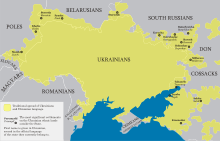
Back Аукраин бызшәа Abkhazian Oekraïens Afrikaans Ukrainische Sprache ALS ዩክሬንኛ Amharic Idioma ucrainés AN Ucrægnisc sprǣc ANG युक्रेनी भाषा ANP اللغة الأوكرانية Arabic لأوكرانية ARY اوكرانى ARZ
| Harshan Ukraniya | |
|---|---|
| українська мова | |
'Yan asalin magana |
harshen asali: 26,900,000 (2023) harshen asali: 27,300,000 (2019) 34,710,100 (2003) |
| |
|
Cyrillic script (en) | |
| Lamban rijistar harshe | |
| ISO 639-1 |
uk |
| ISO 639-2 |
ukr |
| ISO 639-3 |
ukr |
| Glottolog |
ukra1253[1] |
 | |



Yaren mutanen Ukraine, [ʊkrɐˈjinjsjkɐ ˈmɔʋɐ]). yare ne na Gabashin Slavic na dangin yaren Indo-Turai da ake magana da farko a Ukraine. Harshen asali yawancin Ukrainians ne.
Rubutun Ukrainian yana amfani da haruffa na Ukrainian, bambancin Rubutun Cyrillic. Kwalejin Kimiyya ta ƙasa ta Ukraine, (NANU; musamman ta Cibiyar Harshen Ukrainian). da Cibiyar Nazarin Harshe ta Potebnia suna nazarin harshen Ukrainian. [2] [3] yawa ana kwatanta su da Rasha, wani yaren Slavic na Gabas, amma akwai ƙarin fahimtar juna tare da Belarusian.[4][5]
Ukrainian ya fito ne daga Tsohon Gabashin Slavic, yaren da ake magana a cikin jihar Kievan Rus' ta zamani. A cikin Grand Duchy na Lithuania, yaren ya ci gaba zuwa Ruthenian, inda ya zama harshen hukuma, kafin a fara aiwatar da Polonization a cikin Polish-Lithuanian Commonwealth. [6][7] karni na 18, Ruthenian ya rabu zuwa bambance-bambance na yanki, kuma yaren Ukrainian na zamani ya bunkasa a yankin Ukraine ta yanzu. Rushewa ta ga an haramta yaren Ukrainian a matsayin batun daga makarantu kuma a matsayin harshen koyarwa a Daular Rasha, kuma ya ci gaba a hanyoyi daban-daban a Tarayyar Soviet. haka, yaren ya ci gaba da ganin amfani a duk faɗin ƙasar, kuma ya kasance mai ƙarfi ,musamman a Yammacin Ukraine.
- ↑ Hammarström, Harald; Forkel, Robert; Haspelmath, Martin, eds. (2017). "Harshan Ukraniya". Glottolog 3.0. Jena, Germany: Max Planck Institute for the Science of Human History.
- ↑ Alexander M. Schenker.
- ↑ Alexander M. Schenker.
- ↑ Alexander M. Schenker. 1993. "Proto-Slavonic", The Slavonic Languages. (Routledge). pp. 60–121. p. 60: "[The] distinction between dialect and language being blurred, there can be no unanimity on this issue in all instances..." C.F. Voegelin and F.M. Voegelin. 1977. Classification and Index of the World's Languages (Elsevier). p. 311, "In terms of immediate mutual intelligibility, the East Slavic zone is a single language." Bernard Comrie. 1981. The Languages of the Soviet Union (Cambridge). pp. 145–146: "The three East Slavonic languages are very close to one another, with very high rates of mutual intelligibility...The separation of Russian, Ukrainian, and Belorussian as distinct languages is relatively recent...Many Ukrainians in fact speak a mixture of Ukrainian and Russian, finding it difficult to keep the two languages apart..." The Swedish linguist Alfred Jensen wrote in 1916 that the difference between the Russian and Ukrainian languages was significant and that it could be compared to the difference between Swedish and Danish. Jensen, Alfred. Slaverna och världskriget. Reseminnen och intryck från Karpaterna till Balkan 1915–16.. Albert Bonniers förlag, Stockholm, 1916, p. 145.
- ↑ Alexander M. Schenker. 1993. "Proto-Slavonic", The Slavonic Languages. (Routledge). pp. 60–121. p. 60: "[The] distinction between dialect and language being blurred, there can be no unanimity on this issue in all instances..." C.F. Voegelin and F.M. Voegelin. 1977. Classification and Index of the World's Languages (Elsevier). p. 311, "In terms of immediate mutual intelligibility, the East Slavic zone is a single language." Bernard Comrie. 1981. The Languages of the Soviet Union (Cambridge). pp. 145–146: "The three East Slavonic languages are very close to one another, with very high rates of mutual intelligibility...The separation of Russian, Ukrainian, and Belorussian as distinct languages is relatively recent...Many Ukrainians in fact speak a mixture of Ukrainian and Russian, finding it difficult to keep the two languages apart..."
- ↑ Empty citation (help)
- ↑ Empty citation (help)